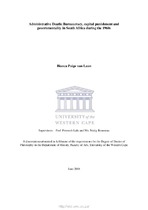Administrative death: Bureaucracy, capital punishment and governmentality in South Africa during the 1960s
Abstract
On 15December 2011, the now ousted South African President Jacob Zuma officiated the opening of the Gallows Memorial Museum at the Pretoria Central Correctional Facility, a project undertaken by the Department of Correctional Services. This Project saw the gallows at what was previously Pretoria Central Maximum (C-Max) Prison, which had been dismantled in 1996 following the abolition of the death penalty in South Africa, restored and reopened as a museum. At the top of the notorious 52 steps that condemned prisoners climbed to reach the execution room, the then president unveiled a dedicated wall with individualised plaques for each of the political prisoners who had died there between 1960 and 1989. “Today” the president announced, “all 134 names are officially being enshrined for eternity so that future generations will know what this country went through, so that we never go through a similar horror ever again.
The Museum is meant to act as an anti-death penalty monument, to honour the anti-apartheid activists who were hanged by the apartheid state and to encourage “healing.” This was to be “a place where the political prisoners who were hanged there can be honoured and the past can be buried. Reflecting the African National Congress (hereafter ANC)- centered dominant narrative of resistance in South Africa, Zuma emphasised the executions of ANC cadres. He failed to note that the Pan Africanist Congress was the organisation that had lost the greatest number of its members to judicial executions.

